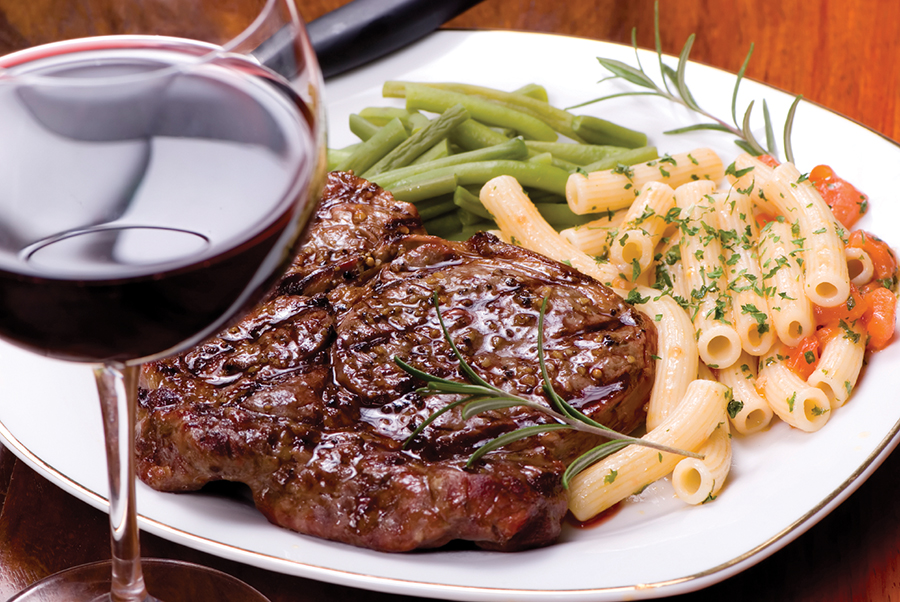By Matthew DeBord
HQ 70 | SUMMER 2010
Now that Huntington has a new steakhouse, the entire town can turn its attention to, hands down, the absolute most compelling and satisfying category of wines. That’s right, steak wines.
The book on steak wines is that they must be big, powerful and red. And in fact at lots of legendary steak houses, such as The Palm in Los Angeles and Spark’s in New York, that’s what tends to happen. Order a well-grilled medium-rare ribeye steak. Pair with luscious inky-dark California Cabernet Sauvignon. Take up your knife. Take up your fork. Take up your glass. Dig in.
It actually can be that simple. There’s nothing wrong with going for what has become something of a modern classic pairing. And it’s no accident that many, many steakhouses are heavy on the Cabs – they do pair well with seared, aged red meat that is ever so slightly pink at the core.
So I’m not going to take an entirely counterintuitive angle here and say that, although you’re supposed to drink monster reds with steak, you should consider some other options – shaking off the tyranny of Cabernet, so to speak. My default choice with steak is pretty much Cali Cab, as long as I’m at the steakhouse and committed to spending some money. (There are very good, moderately priced Cabs, but you do need to stretch into the pricier reaches in order to experience something special.)
Still, you have alternatives. In many cases, this is stipulated by the cut of the meat. Well-marbled, aged steaks, with their relatively high fat content, get along nicely with the rich tones of Cabernet. When you get into the buttery, blood-sweet flavors of your typically not-inexpensive slab of corn-fed steakhouse beef, you can truly see this. That’s the American way. But there are other cuts that allow you to deviate from the Cab route.
And that’s the thing: there are many, many cuts of steak, from many different parts of the steer. Steakhouses traffic in a narrow range, but that isn’t all there is. So don’t limit yourself. And don’t limit your choices.
For example, take the famous New York strip steak, a chewier cut that can allow you to branch out. While richer cuts suggest an Opus One, Robert Mondavi Reserve Cab or Phelps Insignia – all from California – a New York steak might put you, as it often does me, in the mindset for a Malbec from Argentina. Malbec was for many years a blending grape in Bordeaux, as well as the main grape varietal in the southwestern French region known as Cahors. In both of these places, it brings a rustic oomph to its wines.
In Argentina, however, Malbec achieves refinement. It also goes well with the grass-fed beef that Argentines like to eat by the pound. (Argentina is perhaps the world’s most enthusiastically carnivorous nation.) The old French rustic edge has been transformed into something that, for lack of a better word, is kind of crispy, while still smooth. The fruit flavors are rich and supple. There’s a mineral element that gets along with the more sinewy, tangy grass-fed beef.
Grass-fed beef isn’t the norm in the U.S., but New York steaks are denser than a lot of other cuts and, as a result, don’t mate as well with thick, syrupy Cabs. For them, Malbec makes sense.
At many steakhouses, the steaks aren’t really grilled but broiled. This means that they lack any wild or woody flavors that grilling might impart and creates a nice backdrop for the more complex tastes present in fruit-driven red wines. However, if you throw your steaks on a smoking Weber, you’re going to wind up with some grilly aromas and flavors that might get along better with a California Syrah or a wine from France’s Rhone region. These wines are often full of herbal tastes that go beautifully with grilled meat.
Whites? You’ll horrify a steak lover if you even bring this up, but there’s a case to be made, again, for white wines with certain cuts of steak, cooked in certain ways. Honestly, I don’t generally go there myself, but when people do ask me about white wines with steak, I usually say that you can go with Riesling, Champagne or Chardonnay. For filet mignon, Chardonnay is particularly good, given its oakybuttery profile in the California version. It goes well with the melt-in-your-mouth sweetness of a filet. Champagne goes with everything. And Riesling offers a range of flavor profiles, from dry to very sweet, and is a good accompaniment traditionally for game. Steak isn’t game, but it’s close enough.
What about lighter reds, such as Pinot Noir? Again, not my thing, but why not? The fat in steak needs a certain amount of acidity to take the edge off, and Pinot certainly has that. Personally, I’d gravitate toward Northern California Pinots, particularly those from the Russian River Valley.
On the French front, you might logically look to Bordeaux, primarily because many steakhouses keep plenty of red Bordeaux on hand. The marriage can be pretty divine, but Bordeaux really prefers lamb. I usually look to southern French regions, instead. That said, if you can find a nice bottle of Chateau Latour, go for it.
Um … beer? Well, if you must. This is a bare-knuckled combo, pretty old school. I don’t care for it. But something like Sam Adams Boston Lager works. If wine isn’t your thing, how about a martini?
Obviously, dropping serious money on a major league red wine isn’t for everyone. But remember, an inexpensive red wine can also get along well with steak. You don’t have to break the bank. The whole point is that you pair your steak with some kind of wine. Because if you don’t, you’re missing out.





